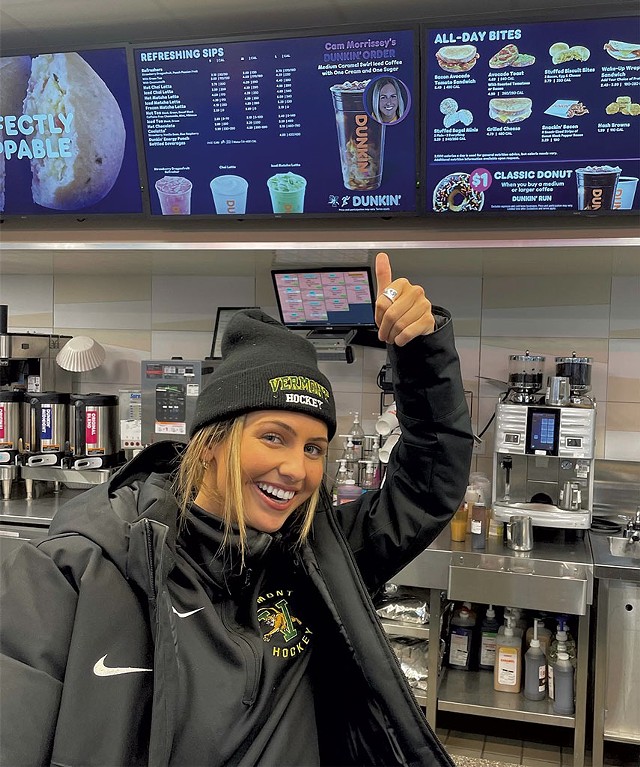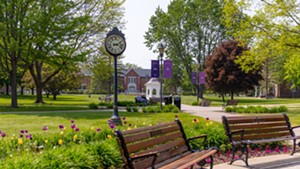
- Courtesy
- Cam Morrissey of the UVM women's ice hockey team in front of the Dunkin' menu
Late last year, University of Vermont senior Cam Morrissey saw an opportunity to earn some extra money to help her make ends meet. She picked up a part-time gig at a local Dunkin' shop — or, more accurately, at every Dunkin' in the state.
The 21-year-old business major from Troy, Mich., wasn't slinging crullers and mocha lattes between classes. For a few months starting in January, whenever customers entered a Dunkin' in Vermont, they would see Morrissey's name, face and favorite beverage — a medium caramel swirl iced coffee — on the restaurant's digital menu board.
"Which was pretty entertaining," she said. "A lot of my friends got a good laugh out of that."
In December, Morrissey, who plays on the UVM women's ice hockey team, signed a three-month deal allowing Dunkin' to use her name, image and likeness, or NIL, in its marketing materials. In return, she got "a ton of apparel and all the goodies," including a stack of gift cards and a paycheck. Morrissey didn't disclose how much she was paid except to say, "I don't have to worry about rent for the next couple of months."
Morrissey wasn't alone in scoring that sweet deal with Dunkin'. She was one of 31 athletes from 24 colleges and universities, along with the entire women's field hockey team at Northwestern University, recruited to Team Dunkin'. The nationwide marketing campaign capitalized on a July 2021 policy change by the National Collegiate Athletic Association that now allows student athletes to profit from their participation in college sports.
Since then, dozens of other college athletes in Vermont have taken advantage of the NIL rule change, which resulted from an antitrust lawsuit that challenged the NCAA's previous restrictions on student athlete compensation. In June 2021, the U.S. Supreme Court ruled unanimously that those restrictions violated the Sherman Antitrust Act, thus opening the floodgates to lucrative deals between businesses and college players.
Supporters of the NIL policy, including many directors of college athletic departments, say the reform was long overdue given the enormous sums of money involved in collegiate sports — $15.8 billion in Division I alone in 2019, according to the NCAA. Since July 2021, tens of thousands of student athletes have licensed their NIL, often through online marketing platforms that promote the athletes' services, much the way vacation and travel sites Airbnb and Vrbo do.
But even advocates of the NIL rule say it's already changing the landscape of college sports in terms of recruitment and competition among schools, and not just at elite Division I schools. Division II and III athletes, and even some high school players, are securing NIL deals, too. Those involved in student sports say it may be time for legislation to ensure that all schools and student athletes are competing on a level playing field.
UVM director of athletics Jeff Schulman, who supports allowing players to profit off their collegiate careers, described the NIL policy as "part of the natural evolution of college athletics." He knows of about 90 "NIL transactions" involving 40 to 50 student athletes who play for UVM's 18 varsity teams.
The types of NIL activities permitted under NCAA rules are broad, Schulman explained. They range from single-day events, such as a player signing autographs at a local business, to weeklong training clinics and summer camps for younger athletes to open-ended product endorsement deals with equipment and apparel manufacturers.
NCAA rules prohibit the use of NIL to promote gambling, tobacco or alcohol use. Also out of bounds are "pay-to-play" contracts, such as those used as recruitment incentives or as rewards for athletic performance.
In a sense, allowing student athletes to profit off their college careers is a matter of fairness. Just as art, music and writing majors can sell their creative works, and engineering students can secure patents for inventions conceived in the classroom, student athletes can now earn money off their primary activities on campus.
"Being a varsity athlete at any level, especially at the Division I level, is a major commitment, both in terms of time and emotion, frankly," Schulman said. During a player's primary season, he explained, athletes are typically involved in 20 hours a week of "countable athletic activity," including practices, strength training, team meetings and classroom video sessions. Additionally, student athletes spend time traveling to and from games and tournaments, all of which make gainful employment impractical, even in the off-season.
With her six-days-a-week training schedule during hockey season, Morrissey said having a part-time job was "basically off the table ... It is so demanding, and there are so many things that take up your time."
Morrissey's NIL deals — she just secured a second, smaller one with an app called BuddyBet — also gave her real-world business experience that her peers would get through summer jobs and internships, for which she never had time.
Indeed, for many college athletes, especially those who've been competing since they were young children, NIL deals are often the first "job" they've ever had, said Braly Keller, NIL and business insights manager for Opendorse, an online marketplace that connects athletes with advertisers and sports agents. Founded in 2012, the Lincoln, Neb.-based company previously worked with Olympic, professional and retired athletes. Once the NCAA changed its NIL rule, the number of athletes on Opendorse jumped from 35,000 in July 2021 to more than 100,000 today.
Essentially, Opendorse operates like a social media site. Athletes create their own free profiles, where they can "promote themselves just like they'd be promoting a business that they launched," Keller said.
There, student athletes can monetize their NIL through a variety of offerings: public appearances, autograph sales, product endorsements, social media posts, birthday shout-outs and "encouragement videos." It's how Dunkin' found UVM's Morrissey, who is both photogenic and already had a sizable social media following.
"They DMed me on Instagram," she recalled. "At first I didn't even think it was real."
Opendorse, which makes its money through transaction fees charged to sponsors, works with many major national brands, including Pepsi, Toyota, Capital One, IBM, Hershey and Foot Locker. The site acts as neither agent nor broker, Keller said, and doesn't promote certain athletes over others. Beyond the traditional sports that typically attract sponsorship deals, Opendorse is available to virtually all college athletics, including cheerleading, dance, bowling and rifle.
A search of Opendorse turned up 47 athletes with Vermont connections, most of them at UVM. They ranged from track-and-field competitors to lacrosse and soccer players to nearly a dozen members of the men's basketball team.
Though UVM is Vermont's sole Division I school, it's not the only one where student athletes are cashing in on their sweat equity. Currently, four athletes at Middlebury College have reported NIL deals, as have "a few" athletes at Saint Michael's College since 2021, though none is currently playing, St. Mike's athletic director Chris Kenny said. (Most colleges and universities require their athletes to disclose such deals.)
Ed Hockenbury, Norwich University's director of athletics, didn't think he'd have to concern himself with NIL once he moved to Norwich from his previous job at UVM. After all, Norwich is a Division III school, and he assumed sponsors wouldn't have much interest in athletes from the small, private military college in central Vermont.
He was wrong. Two of his athletes — Riley Geyer, a men's baseball and football player; and Rylie McIntyre, a women's ice hockey player, both from Maine — recently signed NIL deals with an Augusta, Maine, firm called Pliable Marketing. While Hockenbury didn't disclose the terms of those contracts, he described them as modest.
"Neither of them is getting rich off of it, but I say, good for them," Hockenbury added. "Historically in the NCAA, athletes were taken advantage of in terms of institutions profiting off their name, image and likeness. So why shouldn't the individual student athlete benefit from that?"
Since their origins in the 19th century, college sports have had a complicated relationship with money and students. As U.S. Supreme Court Justice Neil Gorsuch noted in his June 2021 opinion in NCAA v. Alston, in 1852 students from Harvard and Yale universities participated in what many consider the first-ever intercollegiate competition: a boat race on New Hampshire's Lake Winnipesaukee. A railroad executive sponsored the event to promote train travel to the lake and offered competitors an all-expenses-paid vacation with lavish prizes and unlimited alcohol.
When the NCAA was created in March 1906 as a standard-setting body for college sports, its founding principles stated that "no student shall represent a college or university in any intercollegiate game or contest who is paid or receives, directly or indirectly, any money, or financial concession." However, enforcement of that principle has varied wildly over the years, with elite athletes often securing backroom deals and receiving lavish gifts from schools, sponsors and boosters.
Meanwhile, colleges and universities have long used their athletics programs to boost enrollment, attract donors and reap huge profits from licensing rights. The NCAA's current broadcast contract for the March Madness basketball tournament is worth more than $1 billion annually.
Currently, the NCAA isn't tracking the state-by-state value of NIL contracts. But last July, Opendorse issued a white paper, titled "N1L: One Year of Name, Image and Likeness," which projected that $1.14 billion would flow into NIL deals by June 2023.
Athletic directors Schulman and Hockenbury both expressed concern about how NIL is reshaping college sports, especially recruitment. Though NCAA policy clearly prohibits NIL from being used to induce a student to enroll, "You just have to open up the newspaper any day and you can probably find that that envelope is being pushed," Schulman said. "It is part of the recruitment landscape right now."
Moreover, the age for securing NIL deals seems to be dropping by the day, with the Opendorse white paper referencing student athletes as young as ninth graders potentially getting them. It's conceivable that, one day, a high school skier or snowboarder from Vermont could be offered an NIL deal. For this reason, the Vermont Principals' Association is currently drafting an NIL policy to address such deals.
In the meantime, athletes such as Morrissey are taking advantage of their athletic careers while they still have them. Though she briefly considered playing hockey professionally in Europe, Morrissey was offered a sales and marketing job with a Philadelphia fashion company that was "too good to pass up."
For his part, Schulman said he's working to ensure that NIL doesn't become a distraction for UVM athletes.
"Some of this NIL activity can be really time-consuming," he said. "When we talk to our student athletes about it, we make sure they're not overcommitting in terms of what they're promising to a company. NIL can be overwhelming in itself, the way a job can be."












Comments
Comments are closed.
From 2014-2020, Seven Days allowed readers to comment on all stories posted on our website. While we've appreciated the suggestions and insights, right now Seven Days is prioritizing our core mission — producing high-quality, responsible local journalism — over moderating online debates between readers.
To criticize, correct or praise our reporting, please send us a letter to the editor or send us a tip. We’ll check it out and report the results.
Online comments may return when we have better tech tools for managing them. Thanks for reading.